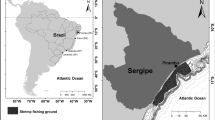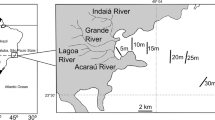Abstract
Quantitative sampling of littoral and sublittoral populations of Pisidia longicornis (L.) and a littoral population of Porcellana platycheles (Pennant) has been carried out over a 2 year period (1970/1972). On the shore, P. longicornis were most abundant at mean low water spring (MLWS), whereas P. platycheles were found mostly at lower mid-shore level. Differences were found between littoral and sublittoral P. longicornis. Sublittoral females are gravid for a slightly shorter period (April to September), carry more eggs, and are smaller than littoral females. It is suggested that their lifespan may also be shorter than that of littoral individuals. Young of both species settle in autumn and grow until December, when growth ceases until the following spring. Numbers decline in the summer months due to the mortality of older individuals. Many sublittoral and some littoral P. longicornis are sexually mature towards the end of their first year on the shore, and may copulate after the early spring moult and carry eggs in the subsequent summer months. P. platycheles appear to follow a similar basic pattern, but results are less clear.
Similar content being viewed by others
Literature Cited
Bell, T.: A history of the British stalk-eyed Crustacea, 386 pp. London: van Voorst 1853.
Carlisle, D. B. and Sir F. Knowles: Endocrine control in crustaceans, 120 pp. Cambridge: University Press 1959.
Clark, J. A.: Notes on Cornish Crustacea. 1: Brachyura and Macrura. Zoologist 13, 281–308 (1909).
Crawshay, L. R.: On the fauna of the outer western area of the English Channel. J. mar. biol. Ass. U.K. 9, 292–393 (1912).
Crothers, J. H.: The biology of the shore crab Carcinus maenas (L.) Fld. Stud. 2, 407–434 (1967).
Field Studies Council: Dale Fort marine fauna, 2nd. Ed. 169 pp. London: Field Studies Council 1966.
Holthuis, L. B. and E. Gottleib: An annotated list of the decapod Crustacea of the Mediterranean coast of Israel, with an appendix listing the Decapoda of the Eastern Mediterranean. Bull. Res. Coun. Israel (Sect. B) 7, 1–126 (1958).
Kensler, C. B.: Desiccation resistance of intertidal crevice species as a factor in their zonation. J. Anim. Ecol. 36, 391–406 (1967).
— and D. J. Crisp: The colonisation of artificial crevices by marine invertebrates. J. Anim. Ecol. 34, 507–516 (1965).
King, P. E. and A. Osborn: Oyster dredging. Gower 20, 1–5 (1969).
Lebour, M. V.: The larvae of the genus Porcellana and related forms. J. mar. biol. Ass. U.K. 25, 721–737 (1943).
Marine Biological Association: Plymouth marine fauna, 3rd. Ed. 457 pp. Plymouth: 1957.
Monod, Th.: Sur quelques crustacés de l'Afrique occidentale. Bull. Com. Etud. hist. scient. Afr. occid. fr. 15, 1–456 (1933).
Naylor, E.: Seasonal changes in a population of Carcinus maenas in the littoral zone. J. Anim. Ecol. 31, 601–609 (1962).
Nelson-Smith, A.: Surveying rocky shores. Fieldworker 1, 50–52 (1970).
Nicol, E. A. T.: The feeding habits of the Galatheidae. J. mar. biol. Ass. U.K. 18, 87–106 (1932).
Norman, A. M.: A month on the Trondhjem fiord. Ann. Mag. nat. Hist. (Ser. 6) 13, 112–133; 150–164 (1894).
Pike, R. B.: Galathea. L.M.B.C. Memoir XXXIV, 178 pp. Liverpool: University Press 1947.
Samuelson, T. J.: The biology of six species of Anomura (Crustacea: Decapoda) from Raunfjorden, Western Norway. Sarsia 45, 25–52 (1970).
Stebbing, A. R. D.: Growth of Flustra foliacea (Bryozoa). Mar. Biol. 9, 267–273 (1971).
Thorson, G.: Reproduction and larval development of Danish bottom invertebrates, with special reference to the planktonic larvae in the sound (Øresund), 523 pp. Copenhagen: Reitzel 1946.
Thurston, M. H.: The marine flora and fauna of the Isles of Scilly. Crustacea, Eucarida. J. nat. Hist. 4, 239–248 (1970).
Wolff, W. J. and A. J. J. Sandee: Distribution and ecology of the Decapoda reptantia of the estuarine area of the rivers Rhine, Meuse and Scheldt. Neth. J. Sea Res. 5, 199–226 (1971).
Author information
Authors and Affiliations
Additional information
Communicated by J. H. S. Blaxter, Oban
Rights and permissions
About this article
Cite this article
Smaldon, G. Population structure and breeding biology of Pisidia longicornis and Porcellana platycheles . Marine Biology 17, 171–179 (1972). https://doi.org/10.1007/BF00347308
Accepted:
Issue Date:
DOI: https://doi.org/10.1007/BF00347308




